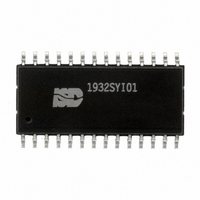ISD1932SYI01 Nuvoton Technology Corporation of America, ISD1932SYI01 Datasheet - Page 9

ISD1932SYI01
Manufacturer Part Number
ISD1932SYI01
Description
IC VOICE REC/PLAY 64SEC 28-SOIC
Manufacturer
Nuvoton Technology Corporation of America
Series
ISD1900r
Datasheet
1.ISD1932SYI.pdf
(29 pages)
Specifications of ISD1932SYI01
Interface
Pushbutton
Duration
21.2 - 64 Sec
Mounting Type
Surface Mount
Package / Case
28-SOIC (0.300", 7.50mm Width)
For Use With
ISD-COB1964 - BOARD DEMO FOR ISD1964/32ISD-COB1916 - BOARD DEMO FOR ISD1916
Lead Free Status / RoHS Status
Lead free / RoHS Compliant
Filter Pass Band
-
MIC+ / AnaIn
¯¯¯¯¯/FMC2
¯¯¯¯¯/FMC3
PlayE
XCLK
PIN NAME
MIC- / NC
REC
¯¯¯¯/ R ¯¯/P
V
Rosc
¯¯¯¯
AGC
V
LED
SP+
FT
¯¯
SSP1
CCA
PIN #
16
17
18
19
20
21
22
23
25
26
15
24
I / O
O
O
I
I
I
I
I
I
I
I
I
I
Depending on the derivative selected, it could be:
SP+: Positive signal of the differential Class-D PWM speaker outputs. This
output, together with the SP-, is used to drive an 8Ω speaker directly.
Or,
AUX out: single-ended voltage output.
Ground: Ground for positive PWM speaker driver.
Automatic Gain Control (AGC): The AGC adjusts the gain of the
preamplifier dynamically to compensate for the wide range of microphone
input levels. The AGC allows the full range of signals to be recorded with
minimal distortion. The AGC is designed to operate with a nominal
capacitor of 4.7 µF connected to this pin.
Connecting this pin to ground (V
preamplifier circuitry. Conversely, connecting this pin to the power supply
(V
MIC+: Non-inverting input of the differential microphone signal.
AnaIn: When FT
input with 1Vp-p maximum input amplitude and feed-through to the speaker
outputs.
MIC-: Inverting input of the differential microphone signal. While FT
enabled, MIC- pin is disabled and must be floated.
Oscillator Resistor: Connect an external resistor from this pin to V
select the internal sampling frequency.
Analog Power Supply: Power supply for analog circuits.
LED output: During recording, this output is Low. Also, LED
momentarily at the end of playback.
¯¯¯¯¯: In Address Mode, low active input, edge-trigger playback from start
to end addresses & toggle on-off. Debounce & internal pull-up existed.
FMC2: When Direct Mode is active, FMC2, together with FMC1 & FMC3,
setup various fixed-message configurations.
(toggle on-off), low active, recording from start to end addresses. Debounce
& internal pull-up existed.
R ¯¯/P ( When Direct Mode is active):
• When R ¯¯/P is set to Low, level-hold record operation is selected.
When R ¯¯/P is set to High, edge-trigger & toggle on-off playback operation is
selected.
External Clock: In Address Mode, low active and level-hold input. As XCLK
activated, Rosc pin accepts external clock input signal, provided resistor at
Rosc must be removed. Connecting this pin to High enables device running
on internal clock via Rosc resistor. If not used, XCLK
When Direct Mode is active, FMC3, together with FMC1 & FMC2, setup
various fixed-message configurations.
Feed-Through: Low active input, Level-hold, debounce & Internal pull-up
required. When FT
ended input with 1Vp-p maximum input amplitude and feed-through to the
speaker outputs.
REC
¯¯¯¯: In Address Mode, level-hold (after 1 sec holding) or edge-trigger
PlayE
CCA
) provides minimum gain to the preamplifier circuitry.
¯¯ is selected, the MIC+ input is configured to a single-ended
¯¯ is selected, the MIC+ input is configured to a single-
9
FUNCTION
SSA
) provides maximum gain to the
Publication Release Date: Jan 5, 2009
¯¯¯¯¯ must be at high level.
¯¯¯¯ pulses Low
ISD1900
Revision 0.51
¯¯¯¯¯
SSA
¯¯ is
to











